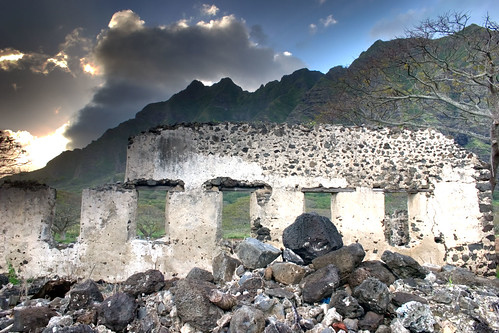Kualoa Sugar Mill Ruins, Hawaii
 Show on map
Show on map
By Jonathan H

The Kualoa sugar cane refinery in Oahu began operation in 1863 by Charles H. Judd and Samuel G. Wilder. It met with little success and closed thirty years later.
 What does bird guano and sugarcane have in common? Well, historical geography often has strange bedfellows. The photo above is the Kualoa Sugar Mill, an enterprise that met with little success and was constructed in 1863.
What does bird guano and sugarcane have in common? Well, historical geography often has strange bedfellows. The photo above is the Kualoa Sugar Mill, an enterprise that met with little success and was constructed in 1863.
It was owned originally by two missionary boys, educated in Hawaii — Charles H. Judd and Samuel G. Wilder. The top layer of bricks was hand-laid by Wilder himself. Both Judd and Wilder would go on to serve as illustrious cabinet members for famed King Kalakaua (the last king of Hawaii).

The history at the mill sings. I knew it was a place that had a lot of stories to tell the moment I set foot on its stones. Constructed of igneous lava rock and meticulously hand-mortared, it’s no wonder that the place has survived 150 years of neglect.
The mill was only in operation for a very short time. In the 1860s, a young boy (probably looking to get a taste of sweet, delicious Hawaiian sugar), fell into a vat and died of severe burns soon afterwards. In the ensuing 30 years, unprecedented droughts hit the Northern Shore of O’ahu, and the cane withered (curse of the dead vat boy?)
Let’s get back to the bird guano & cugar connection (I’m getting there, I promise). After the sugar plantation failure, Judd went off to form his own enterprise after serving on the King’s cabinet (resigned due to “improprieties,” apparently linked to a less-than-flattering cartoon drawn of the King in a burlesque and related derogatory information printed in local newspapers).
Wilder, in the meantime, served only a month on the King’s cabinet (Minister of the Interior). That post apparently lasted just long enough for him to create some sweet railroad acts for himself, so he went about encircling the Hawaiian islands with successful railway routes (more on this in future blog entries).
Judd was the guano guy, but that was long before his King Kalakaua cabinet days, it was even before he built the sugar mill. It was way back in the 1850s, when him and Alfred G. Benson landed on the remote Baker Island and Jarvis Island, 2500 km south of Hawaii in 1857. At the time, Judd represented the American Guano Company (no joke) to claim the islands in the name of the United States under the Guano Act of 1856 (again, not joking). Even before then guano samples had to be collected. The results were a boon, and newspapers touted the rich guano islands as the “new El Dorado” — says the Baltimore American; “it will cover our wasted fields with golden grain.” By 1859, forty-eight islands were taken by the U.S. explicitly for their bird poop, and Judd was well on his way to building a sugar mill.
See! THAT’S the guano-sugar connection! (yeah, i know, it’s tenuous at best, but I still found it fascinating).

 Reddit!
Reddit! Del.icio.us
Del.icio.us Digg
Digg StumbleUpon
StumbleUpon Technorati
Technorati Blinklist
Blinklist Furl
Furl
That’s wonderful history. The first picture is great though!
Hello Jonathan, could you tell me were you find archive fotos? It would be good to use for the book about hawaii in Japanese.
Pingback: Kahuku Marconi Wireless Station, O’ahu, Hawaii - Bearings
I am a descendent of Alfred G Benson.
What are your references?
P Hertzler: So Great to hear from a descendant! I have a few sources used in that corroboration. They are as follow:
http://www.nytimes.com/1865/05/03/news/guano-companies-litigation-case-interest-stockholders-supreme-court-general-term.html
http://www.nytimes.com/1865/06/11/news/title-guano-island-many-millions-dollars-involved-litigation-full-statement-case.html
http://www.janeresture.com/jarvis/
http://www.soest.hawaii.edu/pacioos/region/jarvis.htm
Does anyone know how to contact this location for a possible wedding ceremony?
Also interested in Benson: would love to know what you have found. A.G. Benson sent my “uncle” Robert A. Parker to San Francisco in 1847 as yet another Benson-affiliated merchant and Pacific trade agent. You may find the following helpful about Benson: these references tell that he tried to buy Hawaii for $5M, that he tried to get Brigham Young to contract to give Benson half of Utah in return for assurances of Federal protection; and that a Benson-led grab at Peruvian island guano nearly resulted in a US-Peru war:
New York Times April 20, 1878, “Other Deaths, Mr. Alfred G. Benson.”
Hubert Howe Bancroft, Alan Bates, The Works of Hubert Howe Bancroft: Vol XXVI History of Utah 1540-1886 San Francisco: The History Company, 1889.
Gavan Daws, Shoal of Time: A History of the Hawaiian Islands, University of Hawaii Press, 1968.
Reports of the Committees of the Senate of the United States for the Third Session of the thirty-Fourth Congress, “Memorial of Alfred G. Benson,” Washington: A.O.P.Nicholson, 1857.
Kenneth N. Owens, Gold Rush Saints: California Mormons and the Great Rush for Riches, Arthur H. Clark Company, 2004.
A. G. Benson Company, Agreement with Robert A. Parker New York: DS, 1846 Sept. 5, Bancroft Library, BANC MSS C-Y 41.
The latter item requires a trip to UC Berkeley, but I’ve made a transcript if you are interested. Write me at (combine appropriately) jay w parker (at: the usual at) att (dot) net. The other items are readable through Google or Google Books.